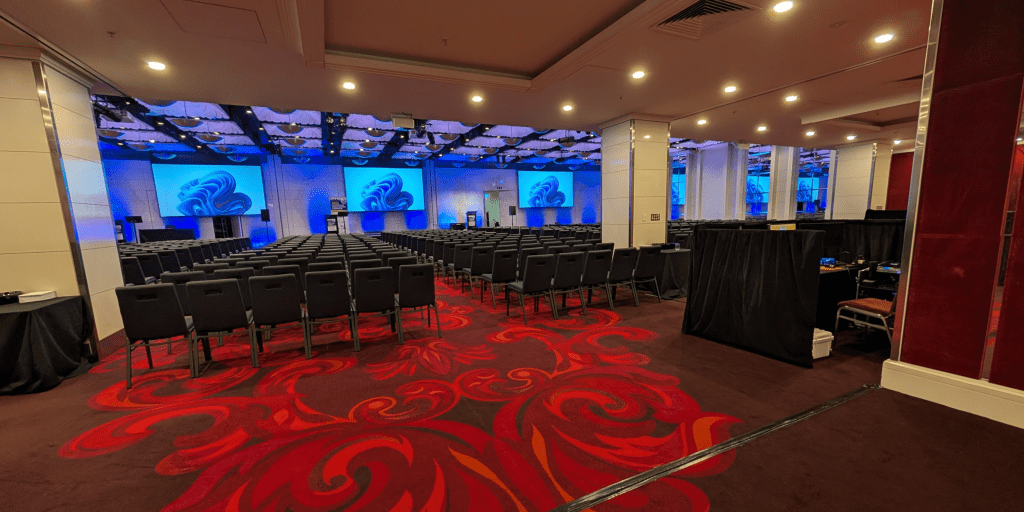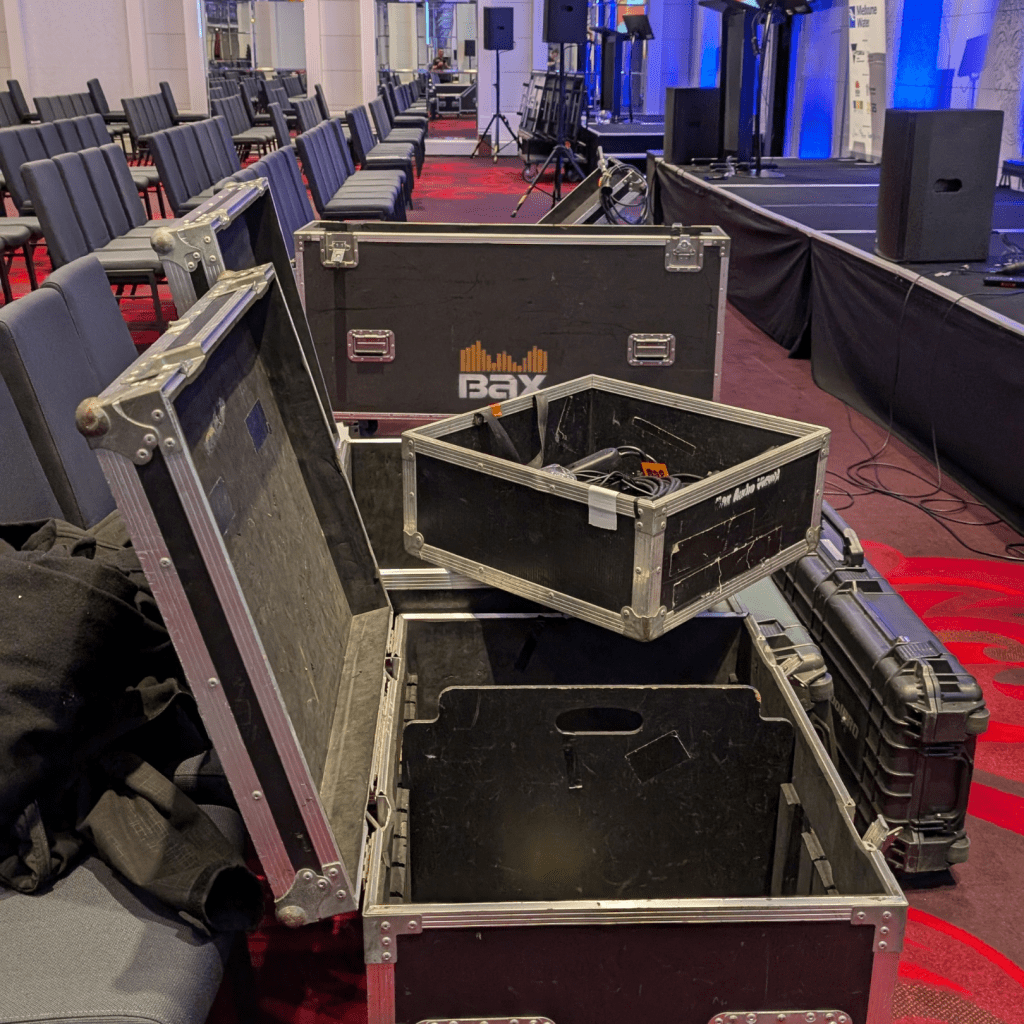
Venue access, timing traps and the one power issue that could derail your show.
In the calm before a conference kicks off; screens on, music up, audience arriving, there’s often a storm of happenings behind the scenes that almost no one ever sees. It’s called the audio visual (AV) bump-in. And while it may sound like a simple setup window, seasoned planners know the moment that makes or breaks the show.
Bax AV has managed hundreds of AV bump-ins around Australia in venues big and small, from hotel conference spaces to major exhibition halls. And if there’s one thing we’ve learned, it’s that the devil’s always in the details, especially the ones you didn’t know to ask about.
Here’s what no one tells you (but you really need to know) when it comes to an AV bump-in.
1. Venue access isn’t always what you think it is
Just because you’ve booked the room from 6am doesn’t mean your AV team can get in then. Access points are often shared with conference coordinators, brand managers, caterers, technicians or still being cleaned after the previous event.
That’s why it’s crucial to meet with your AV team early, not just to discuss equipment but to align on power requirements and venue logistics. Early collaboration ensures they can plan around any access constraints and technical needs, avoiding last-minute surprises on the day.
“Hotels often give external AV teams tight bump-in windows, which means you need a crew that can set up fast, problem-solve on the fly and still deliver a flawless experience under pressure. We’ve also turned up at venues that technically gave us access at 6am for an 8am mic check. That kind of access puts serious pressure on the entire production schedule.” — Dale Bax, Owner, BAX AV
To counter this, we use custom-made racks with built-in microphones, laptops, switchers, timers and pro clickers designed to support shorter setups and adapt to last-minute changes.
A thorough pre-production meeting is essential to iron out arrival times, docking procedures and setup logistics. Check in on arrival to coordinate access and smooth out any kinks before the clock starts ticking.

We use custom-made racks with built-in microphones, laptops, switchers, timers and pro clickers designed to support shorter setups and adapt to last-minute changes.
2. The run sheet is not a bump-in plan
Too often, AV gets treated as a final line item on a run sheet, a tick-box after floor plans, branding, catering and table placement. But a proper bump-in requires its own micro-plan, built in close collaboration with your AV team from the very start.
Today’s events are rarely simple. Same-day room turnarounds from a conference session to a gala dinner, or multiple breakouts to an interactive workshop mean your AV team must plan precisely when equipment arrives, what rigs go up, who’s testing audio, and where lighting focuses. These are not last-minute checks; they are time-critical moves that ripple through every other supplier on site.
Add to this the fact that events are increasingly digitally driven, with technical requirements becoming more complex and unforgiving. Miss key access windows or underestimate rigging time, and the entire production risks falling behind before the show even begins.
Bring your AV team in early. Treat them as essential partners in the planning process, not just service providers and your event will run smarter, smoother, and without last-minute stress.
“The BAXAV team worked with us from the very start of our planning. They helped us realise we needed a full AV timeline, not just a line in our event run sheet. They actually helped us avoid a clash with another supplier we hadn’t even considered and support our needs from beginning to final production, which went off without a hitch. An absolute game-changer.”

Same-day room turnaround from a conference session to a gala dinner
3. The power of decent event planning
One of the biggest oversights in event planning? Power.
One of the most overlooked risks in event production? Assuming the venue’s power setup can handle the full show load.
On major shows, we’re running high-output LED walls, full PA rigs, intelligent lighting, live broadcast gear, and control systems. These all draw serious power and need to run simultaneously. Then catering rolls in and plugs in several urns and needs additional power for their catering needs. Suddenly, you’re overloading a shared distribution board and tripping circuits across the entire venue.
These are not fringe issues. They’re the result of power being treated as a venue detail, not a critical part of production design. That’s why ask our clients to be involved in the upfront planning and always bring our own industrial-grade, plug-and-play power distribution racks, engineered for clean, isolated distribution and built to handle the demands of large-format AV. We test, tag and run our own protected paths so we’re not relying on half-mapped switchboards and guesswork.
“We never just take a venue’s word on power; we discuss and verify it. Our pre-conference checks catch issues early and our three-phase racks give us clean, independent distribution. It means we’re ready to power the full show without compromise.” Dale Bax – Owner BAX AV
Bring Your AV Team in Early — Or Pay for It Later
A professional AV partner won’t just plug things in, they’ll guide you through what’s needed, flag what’s missing and make sure nothing critical is left off the table. It’s the difference between meeting expectations and blowing them. And it’s how you avoid last-minute surprises or being charged for just showing up.
Bring your AV team in early, treat them like part of the planning, not a line item and the whole show runs smarter.
4. Crew logistics matter more than you think
How’s the gear getting in? Where’s the loading dock? Is there lift or ramp access? Can the crew get into the space quickly or are they navigating tight corridors, shared docks or venue delays?
These aren’t minor details, they directly impact how fast and how well your AV team can deliver. Lost time in the first hour of bump-in has a knock-on effect across the entire production schedule. And it’s not just about moving gear, it’s about getting eyes on where the power actually is, how it’s distributed and whether it can safely support what’s been planned and agreed to months in advance.
We’ve turned up to venues with blocked loading zones, out of service lifts and power boards hidden behind locked doors. Every one of these things burns time and when the countdown is tight, that really matters.
A supported crew is a switched-on crew. When logistics are clear, access is smooth and the power setup is known and tested, AV can focus on delivering the show, not chasing cables and lost time.

BaxAV bump in at a recent gala event
5. Communication beats spec sheets, every time
You can have the most detailed tech specs in the world, but without early and open communication with your AV partner, it’s easy to miss the mark. Trust matters. When AV teams are brought in late, critical details often get overlooked and you may end up with equipment that ticks boxes but doesn’t deliver the impact you’re after.
We always recommend looping in your AV partner from day one.
“When we’re part of the process from the start, we’re not just ticking off requirements; we’re helping shape and build a better event from the very start. From venue suitability and load-in timelines to stage layouts that save time and budget, being involved early lets us support you where it counts.”
Dale Bax – owner Bax AV
Why it matters
The AV bump-in is one of the most underestimated moments in any event, yet it sets the tone for everything that follows. Tight venue access, mismatched power supply, missing micro-plans and late communication can throw even the best-run event off-course. It’s not just about gear arriving on time, it’s about knowing how to set up fast, pull down and reset the same room for a quick conference-to-gala dinner turnaround, navigating real-world venue challenges and keeping the show on track.
Importantly, early access can often be negotiated before contracts are signed. Bringing your AV partner in from the very start of your planning allows you to secure these critical windows, ensuring the bump-in runs smoothly and without surprises.
These aren’t extras. They’re essential for delivering a calm, smooth and stress-free event. Involve your AV team early and set the stage for success.
Planning Your Next Event?
If you’re tired of last-minute tech issues, rushed setups or unclear plans, talk to the team at BaxAV. We’ll collaborate with you from the start and help you map out an effective and seamless audio-visual plan that’s not just about lights and cables but about setting your show up for real success and working with you to create the best production possible from the start of your event planning.
Let’s talk about how to make your next AV bump-in the smoothest one yet. Get in touch with Dale and the team today.
